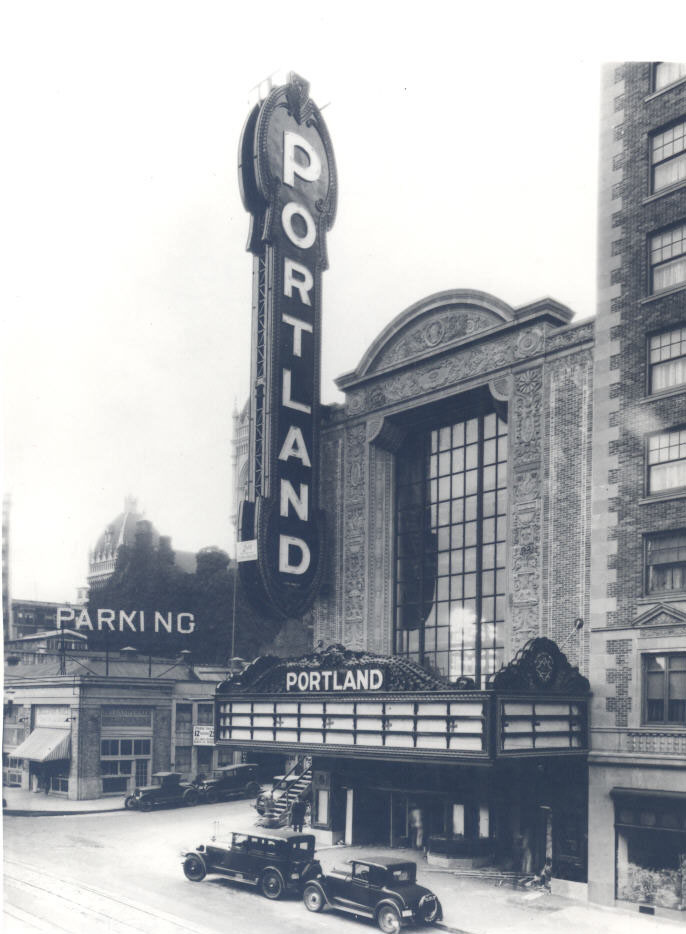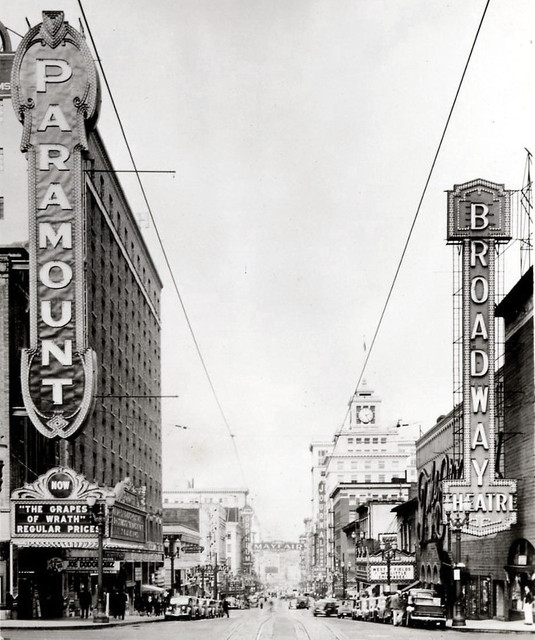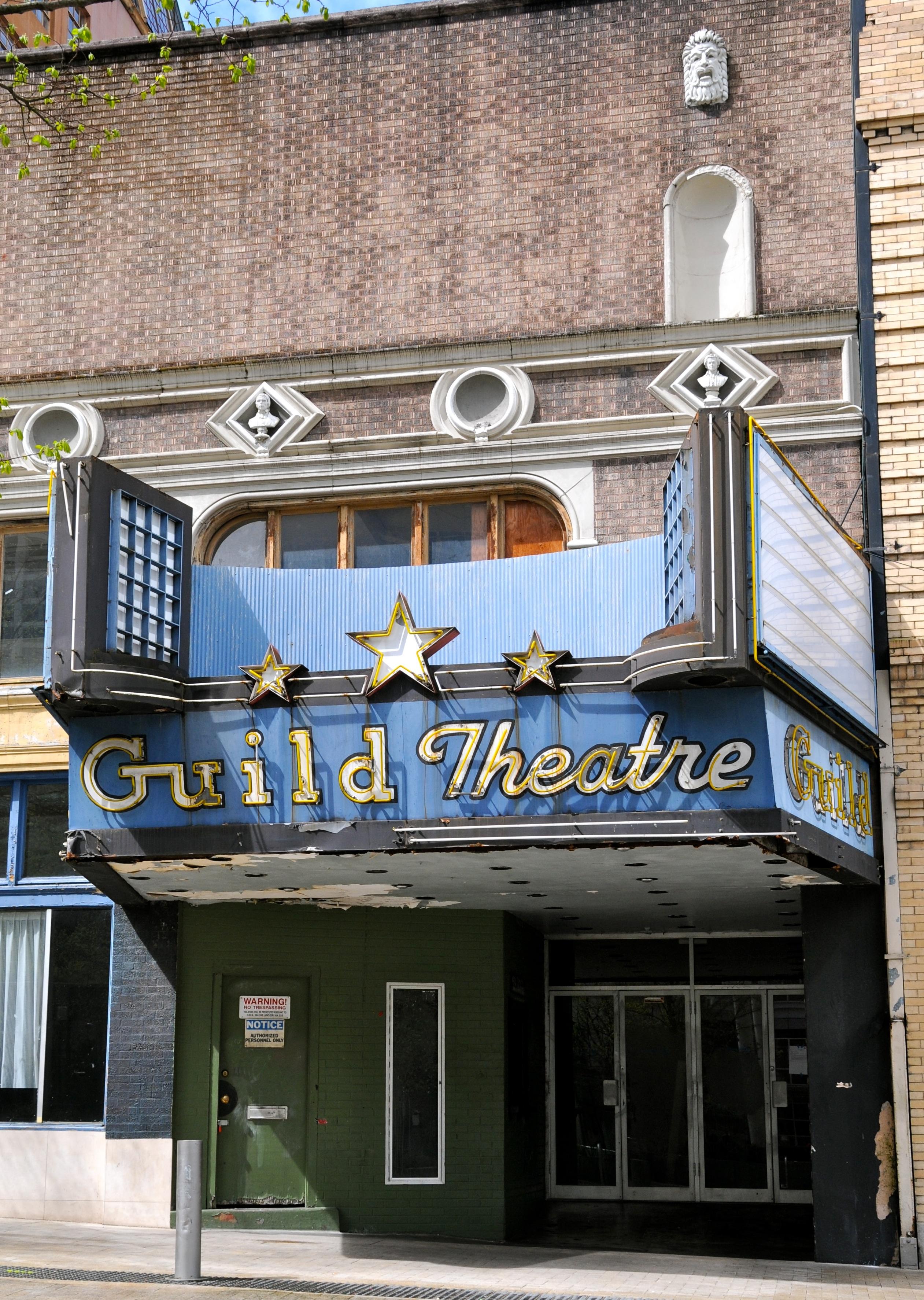The Portland Paramount Theatre once dominated the city’s Great White Way, a series of brightly lit cinemas that dazzled downtowners along Southwest Broadway Street. The ornate building still stands as an architectural treasure that anchors Portland’s cultural scene. Nearly razed in the 1980s, the renamed Arlene Schnitzer Concert Hall has been restored as the home of the Oregon Symphony and as a venue for concerts and other entertainments.
Chicago architects George and Cornelius Rapp, designers of over four hundred theaters nationally, began construction of the $1.5 million building for Portland-Publix Theatres in 1927. Movie fans lined up for hours on the theater’s opening night, March 8, 1928, to fill the 3,036-seat auditorium and to watch New York’s Greenwich Village Follies, hear musical selections from a $46,500 Wurlitzer organ, and see the comic silent film Feel My Pulse.
The historic building retains much of its original elegance, combining French Renaissance styling of natural light, warm colors, and sumptuous décor with Italian Rococo Revival for a floral, villa-like appearance. The brick exterior includes cast stone trim, fleur-de-lis around the roofline, and female faces with cascading curls of hair on the façade facing Main Street.
The grand lobby and foyer were constructed to resemble an opulent French salon with mirrored walls, frescoes, crystal chandeliers, and a grand staircase leading to an open balcony and an unobstructed view of the auditorium. The walls and ceilings retain the swirl of mythological characters, intricate patterns, and the terra cotta images of Roman, Greek, and Chinese cultures that early audiences enjoyed.
The Rapp brothers placed a large bubbling fountain in the lobby, surrounded by four marble statues to represent Europe, Asia, Africa, and America. They furnished lounges with fireplaces, dressing tables, telephones, radios, and personal attendants. Even vaudeville stars’ dressing rooms came with tile showers, private telephones, elevators, and kitchen appliances.
John Hamrick’s Evergreen theater chain purchased the theater and operated it successfully through the 1930s. Attendance grew during World War II, and military personnel in uniform were admitted without charge. In August 1943, bobbysoxers packed in the Paramount to watch Frank Sinatra perform on stage. Through the 1950s and 1960s, the Portland Paramount continued to show first-run films and served as the venue for high school proms, musical events, and private parties.
John Haviland, owner of the Park-Haviland Hotel, adjacent to the Heathman Hotel just north of the Paramount, purchased the building in 1971 and leased it to Tom Moyer, owner of Luxury Theaters. To promote the movie Planet of the Apes, his son Tim Moyer dressed in a gorilla outfit and crawled onto the brightly lit marquee. Waving and howling at passersby, he slipped, became stuck, and had to be rescued by members of the Portland Fire Bureau.
Movie attendance began declining in the 1960s, and Haviland closed the Paramount to films on August 15, 1972. He auctioned off the organ, the statuary, and most of the antique furnishings. The theater continued to host concerts by well-known musicians, such as Santana, Dionne Warwick, BB King, Bonnie Raitt, Jerry Garcia, Ozzy Osbourne, Bruce Springsteen, Bob Marley, and Madonna. And sports fans cheered the Portland Trail Blazers basketball team on a large closed-circuit screen.
The Paramount was listed on the National Register of Historic Places in 1976 and purchased the same year by Seattle-based West Coast Theatres. Local lobbying began in earnest that year, as arts groups called for creating a performing arts center in the city.
On March 31, 1981, city voters approved a $19 million bond levy to construct a four-theater performing arts complex, anchored by the Paramount. When negotiations to purchase the theater broke down two years later, the city condemned the building and paid West Coast Theatres $4.1 million.
A $10 million restoration, led by contributions from real estate investors Arlene and Harold Schnitzer, returned the building to much of its 1928 splendor. Changes included roomier seating for 2,776 people, expanded dressing rooms, and a new entrance on Main Street. Although traditionalists argued for repainting the walls to the original reds, greens, and golds, modernists prevailed with a call for more subdued tones of teal, salmon, and beige.
On September 8, 1984, over a thousand people attended the dedication of the building as part of the city’s new performing arts complex. In 2006, Multnomah County assessed the theater’s value at $36 million. With its 65-foot, 6,000-light Portland sign, Paramount is a landmark in the city’s cultural district.
-
![Portland Paramount, 1928]()
Portland Paramount, 1928.
Portland Paramount, 1928 Courtesy Oreg. Hist. Soc. Research Lib., neg. no.47550
-
![Paramount on Broadway, c.1940s]()
Paramount on Broadway, c.1940s.
Paramount on Broadway, c.1940s Courtesy Cinema Treasures
-
![Portland Paramount, 1946]()
Portland Paramount, 1946.
Portland Paramount, 1946 Courtesy Oreg. Hist. Soc. Research Lib., neg. no.66677
-
![Portland Paramount, interior]()
Portland Paramount, interior.
Portland Paramount, interior Courtesy Oreg. Hist. Soc. Research Lib., neg. no.68394
-
![Portland Paramount, interior]()
Portland Paramount, interior.
Portland Paramount, interior Courtesy Oreg. Hist. Soc. Research Lib., neg. no.68409
-
![Portland Paramount, interior]()
Portland Paramount, interior.
Portland Paramount, interior Courtesy Oreg. Hist. Soc. Research Lib., neg. no. 68419
-
![Portland Paramount]()
Portland Paramount.
Portland Paramount Courtesy Oreg. Hist. Soc. Research Lib., ba017689
Related Entries
-
![Arlene Schnitzer (1929–2020)]()
Arlene Schnitzer (1929–2020)
Arlene Schnitzer was a patron of artists, a philanthropist, and the nam…
-
![Bagdad Theater]()
Bagdad Theater
From its grand opening on January 14, 1927, as movie theater and “Oasis…
-
![Guild Theater]()
Guild Theater
The Guild Theater in downtown Portland is the last survivor of the city…
-
![Hollywood Theatre]()
Hollywood Theatre
On July 17, 1926, Claude C. Jensen and John G. von Herberg, owners of a…
Map This on the Oregon History WayFinder
The Oregon History Wayfinder is an interactive map that identifies significant places, people, and events in Oregon history.
Further Reading
"Paramount (Portland) Theater." Puget Sound Theatre Organ Society. www.pstos.org/instruments/or/portland/paramount.htm
"Portland Theatre Opens Tonight." The Morning Oregonian, March 8, 1928.














